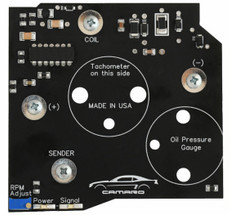Posted by Technical staff on 30th Oct 2024
Trouble shooting the tachometer after the circuit board has been replaced.
If the tachometer still isn’t working after replacing the circuit board, here are some troubleshooting steps to narrow down the likely cause.
We will cover, partial movement of the tachometer needle, no movement, and occasionally jumping of the needle.
If the tachometer partially works:
When a tachometer with two internal windings and three terminals (two independent winding terminals and one common terminal) partially works but the needle jumps or changes position at certain RPMs only, it's likely due to a fault in the motor windings.
Here's a concise breakdown using a 82-89 Camaro OEM tachometer with a maximum range of 7000 RPM and a midpoint at 3500 RPM. The examples are of one failed terminal/circuit at a time.
1. Engine RPM: 750
- Terminal One Faulty: Needle doesn't move; appears dead.
- Terminal Two Faulty: Needle jumps to around 2700 RPM.
- Common Terminal Faulty: Needle moves to 0 RPM.
2. Engine RPM: 3000
- Terminal One Faulty: Needle moves to around 3700 RPM.
- Terminal Two Faulty: Needle jumps to around 2500 RPM.
- Common Terminal Faulty: Needle moves to approximately 5000 RPM.
3. Engine RPM: 5000
- Terminal One Faulty: Needle moves to full-scale deflection (7000 RPM).
- Terminal Two Faulty: Needle jumps to around 3700 RPM.
- Common Terminal Faulty: Needle moves to approximately 5000 RPM.
These patterns indicate that failures in specific windings or the common terminal cause characteristic incorrect readings on the tachometer needle at various engine RPMs. This behavior helps diagnose which winding or terminal may be faulty. Please note aftermarket tachometer may not behave in the same manner:
If the tachometer doesn't work at all:
If the tachometer doesn't work at all, you will need to take steps to diagnose the cause.
- Double-Check Connections: Verify that all the connections (power, ground, and signal) to the tachometer are secure and free of corrosion. Even a small amount of corrosion can cause issues.
- Signal Voltage: Check the signal voltage to see if it changes with RPM changes, use an oscilloscope or a multimeter with a tach function to verify that the signal is clean and within the expected voltage range. The tachometer generally requires a clean square wave signal, so noise or irregularities can cause it to misread or not work at all. Typical frequency range for these types of tachometers is 0-400Hz, increasing frequency with increasing RPM
- Check Signal Compatibility: Make sure the signal coming from the ignition system is compatible with the tachometer. If you’ve upgraded to an aftermarket ignition system, there might be a mismatch in the signal type or voltage, requiring an adapter or filter.
- Inspect Grounding: A weak ground can cause intermittent or non-functioning tachometers. Measure the resistance between the tachometer’s ground point and a known good ground on the chassis or engine block to ensure there’s minimal resistance.
- Try a Direct Signal: Bypass any intermediate wiring by running a temporary direct signal wire from the coil or ignition box to the tachometer. This can help determine if the issue lies with the vehicle’s wiring or the tachometer itself.
- Test with a Known Good Tach: If you have access to another tachometer, connect it temporarily to see if it functions correctly. This will help rule out issues with the tachometer itself.
- Look for Ground Loops or Interference: Sometimes interference from other electrical components can disrupt the tachometer signal. Ensure the tachometer’s ground is isolated from other electrical devices and not sharing a ground with high-current devices like the alternator.
By methodically working through these steps, you should be able to identify where the problem is.
One last consideration. If the tachometer works correctly most of the time but occasionally jumps around, a tachometer signal filter may take care of this issue. You can also learn more about how tachometer filter work by reading our blog post on this topic


